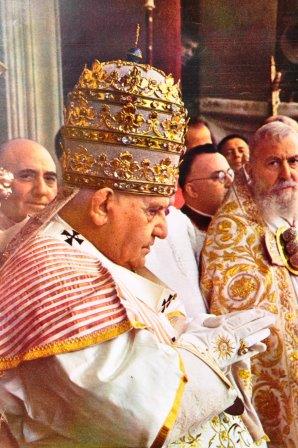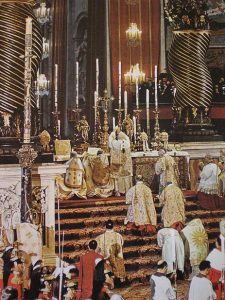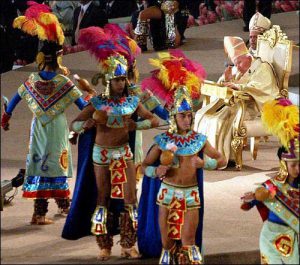 From a reader…
From a reader…
QUAERITUR:
Thank you for your blog. I get so much from it! Never stop!
I know you like one question at a time, but maybe you’ll do this.
I heard a podcast at 1 Peter 5 with Peter Kwasnieski about the Extraordinary Form. It was good but I wonder what you take is on a couple of the things they said. (They didn’t mention you, by the way.)
[1] Why do you think Benedict XVI never said the Extraordinary Form while we was Pope?
[2] What should lay people do to get the old Mass in their parishes?
[3] How do you see the future of the Extraordinary Form?
Thanks for answers to one or all!
Thanks for that. No link to that podcast, so I am a bit hobbled. However, I can’t imagine that they said anything strange. These are smart guys.
1) Why didn’t Benedict XVI never say the Extraordinary Form?
He certainly did not, as Pope, celebrate the Extraordinary Form in public. However, I suspect he could have privately now and then. I say that because, once in while, during Masses I thought I spotted him doing some things that I must be very careful about when I say the Novus Ordo. I don’t say the Novus Ordo very often, and I get into “autopilot”, for example, automatically genuflecting at certain points, automatically tucking the paten, etc. But, that’s not really the question.
I think there were two reasons why Benedict didn’t publicly say the Extraordinary Form. I am convinced that he would have liked to, so there must have been compelling arguments against.
One argument is that to mount a Papal Mass, not just a Pontifical Mass would have been extremely difficult. It was already difficult at the time of John XXIII (who was reviving liturgical uses) and Paul VI (who abolished it all). I used to argue on this blog that Benedict could celebrate not a Papal Mass but at least a Pontifical Mass. I haven’t entirely abandoned that, but it would be seriously deficient. The Pope must be the Pope and must not be just any old bishop. The Papal Mass was so demanding that it was more common for Mass to be celebrated coram Pontifice, itself pretty complex especially when the Pontiff is the Roman Pontiff.
The full Papal Mass, however, had things and roles which were abolished that would have to be revived. Impossible? No. Really hard? Absolutely. Worth the effort? Jury still out.
 For example, the Noble Guard. One of their tasks was to sound silver trumpets at the elevation. Not too hard to overcome: His Holiness snaps his fingers an honorary Guards with trumpet skills can be placed in the tribunals. It could be possible to created titular or honorary positions ad hoc, of course. Heck, there are titular bishops and cardinals get titles in Rome. There’s no reason why there couldn’t be established roles pro hac vice. On the other hand, though there are no Papal Chamberlains any more, the newer-fangled Gentlemen of His Holiness – who replaced them – could take part as train-bearers. There are still Protonotaries Apostolic, so that’s not a problem. Cardinal Deacons still exist, as do Auditors of the Rota. There are not any longer officially appointed Assistants at the Pontifical Throne, but that can be fixed with the scribble of a pen on a napkin. There are still Prince Assistants at the Throne, by the way! The Sedia Gestatoria was not part of Mass per se, and so it wouldn’t be absolutely necessary, but it was part of the plan. Many of the vestments are not used now, but that’s a small detail and, frankly, they still exist in the papal stores and they can be made. A fanon was used by John Paul II and by Benedict XVI.
For example, the Noble Guard. One of their tasks was to sound silver trumpets at the elevation. Not too hard to overcome: His Holiness snaps his fingers an honorary Guards with trumpet skills can be placed in the tribunals. It could be possible to created titular or honorary positions ad hoc, of course. Heck, there are titular bishops and cardinals get titles in Rome. There’s no reason why there couldn’t be established roles pro hac vice. On the other hand, though there are no Papal Chamberlains any more, the newer-fangled Gentlemen of His Holiness – who replaced them – could take part as train-bearers. There are still Protonotaries Apostolic, so that’s not a problem. Cardinal Deacons still exist, as do Auditors of the Rota. There are not any longer officially appointed Assistants at the Pontifical Throne, but that can be fixed with the scribble of a pen on a napkin. There are still Prince Assistants at the Throne, by the way! The Sedia Gestatoria was not part of Mass per se, and so it wouldn’t be absolutely necessary, but it was part of the plan. Many of the vestments are not used now, but that’s a small detail and, frankly, they still exist in the papal stores and they can be made. A fanon was used by John Paul II and by Benedict XVI.
The papal tiara… yes, that was part of the gear, the last thing put on before Mass. Well… they are still around in the Vatican’s treasuries. Also, a Pope could suggest that he would use it and two dozen individuals or organizations would immediately have one made. Using it would absolutely make – even more than all the other stuff – make lib heads explode and all the parrots and ferrets fly out. Which in itself might make it worth it, to answer my rhetorical question above.
So, it would not be impossible but the work to put it together and the fall out afterward might not make it feasible.
 His scriptis, I suspect a deeper and more far-sighted reason. Benedict was a teacher, not an imposer. He reintroduced a few things, such as the sung Gradual and even the Fanon. Small things, but indicative. They were signals, much as, on a smaller scale the late Extraordinary Ordinary in Madison started to celebrate ad orientem on Sundays, a sign to priests that they could move in that direction. Bishop Wall did this in Gallup. Leading by example.
His scriptis, I suspect a deeper and more far-sighted reason. Benedict was a teacher, not an imposer. He reintroduced a few things, such as the sung Gradual and even the Fanon. Small things, but indicative. They were signals, much as, on a smaller scale the late Extraordinary Ordinary in Madison started to celebrate ad orientem on Sundays, a sign to priests that they could move in that direction. Bishop Wall did this in Gallup. Leading by example.
Benedict had magnificent vestments brought out of the treasury that probably made MC Piero (Bad) Marini writhe. At that point, Benedict’s detractors started saying that he was imposing his personal tastes on the liturgy. Never mind that that is what JP2 and Bad Marini did. That was okay! But what Benedict was doing was double-plus-ungood. So, Benedict wanted to avoid that criticism.
Can you imagine what would have resulted from a PAPAL Mass? I used the image of exploding heads. But it also would have run the risk of opening for future Pontiffs to do anything they wanted according to personal preferences. That was, after all the trend ever since the conclusion of Pius’ pontificate. John XXIII applied his personal preferences and revived the camaura and even thought about moving his residence to the Lateran. Oh yes, he announced a Council even though it was advised against. Paul VI imposed an artistic style according to his preferences, sold the tiara, and, oh yes, also the Novus Ordo even though he acknowledged the upheaval it would cause. See my podcasts on that. John Paul II exercised his preference and stopped using the sedia, then adopting a populist low common denominator liturgy with strange inculturation applications according to the preferences of Bugnini’s former secretary Bad Marini.
The trend was that Popes do as they please: they don’t serve the Roman Rite in humility, they alter it according to their will.
Benedict’s whole life was about bringing the Church’s liturgical life back to stability and continuity.
Would reviving the Papal Mass, 40-50 years after the fact, serve well a long-term goal?
Would I have liked to see it? Of course! Old priests in Rome used to describe these Masses. You can see video clips. Amazing. But would it have been … prudent?
Quis sum ego ut iudicem?
What would be far more confounding would be for Francis to command one at full re-assimilation of the SSPX.
2) How to get the TLM in your parish.
I’ve written on this more times than I can count. However, to break this down barney styles, here are some rapid pointers.
 First and foremost, you have to be able to articulate why you want the TLM. Like 1 Peter 3 (not 5!) says, always be ready to give reasons for the hope that is in you, with kindness. So, you should sit down and make lists in columns on paper. Why you want the TLM, its advantages, etc., across from objections to the same and then figure out your responses. That means you might need some good reading. Peter’s books are good for that.
First and foremost, you have to be able to articulate why you want the TLM. Like 1 Peter 3 (not 5!) says, always be ready to give reasons for the hope that is in you, with kindness. So, you should sit down and make lists in columns on paper. Why you want the TLM, its advantages, etc., across from objections to the same and then figure out your responses. That means you might need some good reading. Peter’s books are good for that.
Next, get a group together. Don’t go at this alone. Get on the same page about concrete things, namely, you will pay for all the expenses necessary to obtain vestments, books, booklets or hand missals, etc., and you will handle all the setting up and taking down, unlocking of doors and locking up, send them off for a workshop, etc. In short, you will handle everything so that the priest doesn’t have yet another set of things to do. I suspect that a lot of priests and bishops balk not just because they don’t know what to do – and they don’t like being seen not knowing what to do – but because they frankly have to much to do and this is another thing… and a BIG thing at that. They will have to learn to say Mass in a language they probably haven’t studied, which is intimidating. Be ready with solutions for every possible thing that can be a speed bump or spike strip thrown in the way.
Which brings us to the priest himself. You have to handle the guy with serious TLC. Do not get up in his face or press him. Be persuasive. Also, make sure your group is visibly participating in the life of the parish. Don’t just chopper in and chopper out. This is important after you get what you want! Be an important component in the parish. Keep in mind that, these days, priests are (absurdly) moved every 6 or 12 years, to the detriment of continuity and spiritual paternity of the priest and parish. You could in a few years be faced with Joseph’s situation when a new Pharaoh came.
Each parish and priest will be different. But these tips are, I think, indispensable even if the priest is 100% aboard and just waiting for the request. HE will have to answer to challenges from other priests and maybe the bishop. Be sure that everything he reports is positive. Be part of the solution, not a problem to be solved.
3) How do you see the future of the Extraordinary Form?
 Some years ago, lay friends used to say to me that one day the Novus Ordo would disappear and the Traditional Latin Mass would once again be the Mass of the Latin Church. At the time, I shrugged that off as impossible and that the Novus Ordo wasn’t going away. At the same time, I remembered conversations with Card. Ratzinger years ago which shaped my thought about the old Mass: there should be side by side celebrations and then, as I put it, market forces would prevail. Either people would flock to the TLM and stick with it, or it would be tried and people would reject it. Either way, we shouldn’t fear the results. Also, there is the matter of the “gravitational” pull I think will take place, but let’s leave that.
Some years ago, lay friends used to say to me that one day the Novus Ordo would disappear and the Traditional Latin Mass would once again be the Mass of the Latin Church. At the time, I shrugged that off as impossible and that the Novus Ordo wasn’t going away. At the same time, I remembered conversations with Card. Ratzinger years ago which shaped my thought about the old Mass: there should be side by side celebrations and then, as I put it, market forces would prevail. Either people would flock to the TLM and stick with it, or it would be tried and people would reject it. Either way, we shouldn’t fear the results. Also, there is the matter of the “gravitational” pull I think will take place, but let’s leave that.
However, right now I am also looking at demographics. Demographics suggest, soon, a massive falling away from the Church and a sharp decline in the numbers of priests. Suburban parishes will die. On the other hand, TLMs are populated with committed Catholics with lots of children. Moreover, I keep hearing from seminarians and the newly ordained that the majority in ordination classes each say – or want to say – the TLM for their First Mass. It could very well be that when the dust and rubble settle, the Usus Antiquior will indeed be the predominant form. This might take a while. But even in the shorter term, say 10 years, we might see a entirely different landscape. And we might have to factor in persecution from outside the Church, which could clarify some people’s values.
In addition, a little while ago I wrote about another trend… early trend, I’ll admit… it seems that Catholics from the more “charismatic” side of things are discovering Tradition and the TLM and they are getting into it. That has terrific potential for explosive growth.
In any event, the trajectory is good. The number of TLMs available since Summorum Pontificum has grown tenfold. There is no sign that this is slowing down.
I’ve been fighting this battle since the late 80s and early 90s of the last century. I don’t know if I, at my age, will see the results of this race against the Biological Solution and the agents of the world, the flesh and the Devil.
Bonum certamen certo, cursum consumo, fidem servo. I am glad the young bucks are running with the batons. Before too much longer I’ll have to change those tenses to perfects.

































but that can be fixed with the scribble of a pen on a napkin.
Isn’t that how we got Eucharistic Prayer II?
[How I enjoy such substantive comments right off the bat. Yes, it was something like that. However, abusus non tollit usum. Napkins still have their good uses, EP2 notwithstanding!]
When we started having the EF Mass at our tiny church, we actually had to count heads weekly to make sure there was a faithful group that was committed to the EF Mass. I think the bishop wanted to make sure there was actually people who would attend and wanted it. Flash forward 12 years later…the young families that have come! I talk to them and they want more out of their Mass. The church is typically 3/4 full for that Mass on Sundays. Mind you this is a TINY rural church, most are driving 20+ minutes to get there, some 2 hours. They talk to other young friends with families, and it is taking off! The interesting thing is when I began going to the Mass, I still preferred a “good” Novus Ordo; now, I can not bring myself to go to a Novus Ordo Mass unless we are out of town and it is not possible. I need the silence, the sacred space, the bells, the smells, everything. We continue to grow family wise at our parish, many other parishes are losing families in our area.
One can pray that the TLM is going to be the salvation of the Church. Wonder if Pope Benedict has thought that all along. The N.O. is the N.O. Bugnini and Paul VI did away with the sacredness of the Liturgy. And for that the church’s emptied.
I prefer and always will the TLM (in particular HIgh Mass).
Sure wish we had the FSSP in our town, we have a wonderful Bishop. Don’t know how to approach him on establishing a FSSP parish in our Town.
Praise GOD for the return of the TLM, and the young people who are attending. It is the holiest this side of Heaven,
[I have great respect for the FSSP. But the real renewal will begin with DIOCESAN priests start saying the TLM in larger numbers. That’s when real change will begin. The TLM has to be in parishes, not a parish. Bring diocesan priests into the vision with your full support.]
I believe this is the podcast the questioner heard:
https://youtu.be/k3fd9DPW2Tk
It’s over 100 minutes, so 1.25x speed may be in order.
If I remember correctly, a papal tiara was made for and given to Pope Benedict XVI (as a gift), but I can’t remember what he did with it. Also, does anyone know where footage of a Papal High Mass is to be found online? It would be good for those such as myself who were born after the ordinary form was promulgated. I’ve seen photos, but videos give an even better picture.
While we laymen are busy doing all the things laymen should do, may I offer the caution that we never presume to take over anything which belongs to the clerical state, and in the circumstance where lay help is needed, to surrender that position as soon as clerics are available? I’m a musician, and it’s important to remember that while we may help (in a pinch) in singing all sorts of difficult music, as soon as there’s a cleric up to the job, we must get out of the way and let him do it.
In our parish we sing Vespers once a month. We’ve been blessed with a seminarian on site, and – while my task has been to intone all sorts of things before he arrived – I’m happy to let him intone.
Consider a diocese of 200,000 Catholics, that is neither traditional nor modernist — relative to currently typical norms in the US. Consider a newly ordained bishop the solemnity of whose consecration as such wakened him to a desire to connect himself and his mission (his flock) to Catholic Tradition.
Suppose that after a few months of thinking about this, reading, and praying, he availed himself of training in traditional ritual. Then, where should he lay down the first brick?
Should he start with his own celebration in his cathedral? [Without question, yes.] Should he first forewarn his priests? [He’ll need priests for the Mass. Yes.] Should he ask his priests to institute elements of traditional liturgy – and, if some do not, command them to? [Most will do it anyway.]
Should he reasonably expect within another year to have TLM at least once a week in every church of his diocese? [It’ll probably happen through young priests.]
Looking back, how much would it have cost the Bishop (diocese) in dollars? [Not much.]
Could he be stopped (or made to suffer) from doing this? By a lay Board? By USCCB? By Rome? [No.]
all the parrots and ferrets fly out.
That brought a smile to my face, the more I let my imagination run wild the better the image got, good one Fr
Our Bishops remind me of the Democratic candidates, who are in love with socialism. Socialism has been tried in many countries, and has produced unprecedented disasters. When the affected countries wake up they return to capitalism. The higher ups in the affected countries try their best to keep socialism, because, for a few, they lived off the misery of the many. In many ways our leaders enjoy their perks, and refuse to rock the boat, even though the ship is sinking.
We are desperate for a St. John Fischer, while surrounded by too many Thomas Cranmers. If I sound like an alarmist, just look around at the church and school closing, the sexual predations, and last but not least, the discarding of our belief in the Real Presence. Where are we headed?
“Moreover, I keep hearing from seminarians and the newly ordained that the majority in ordination classes each say – or want to say – the TLM for their First Mass.”
A seminarian here in Los Angeles shared on Twitter that he wants to utilize the EF for mass and the sacraments in his priesthood and he was able to choose diocesan seminary rather than FSSP or similar because of Summorum Pontificum. That’s pretty incredible, don’t you think?
People should take action and DO something, like form an Una Voce group in your area if you have no Latin Mass available in your parish. Una Voce America’s web site currently has an article by Lynne Bissonnette Pitre, who helped organize the first Sacred Liturgy Conference held in Medford, Oregon in 2017, attended by our Archbishop Sample and Cardinal Burke, Bishop Vasa of Napa, and Archbishop Cordileone of San Francisco. That’s quite a swath of the formerly “Left” coast. And our local Una Voce group is still instrumental in coordinating a Latin Mass regularly in our somewhat rural area. There needs to be stable interest and lots of work training priests and choirs and altar boys. But if we can do it here, you can do it anywhere…as they say.